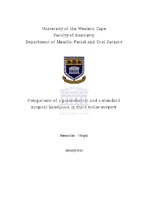| dc.contributor.author | Gopal, Ishmael | |
| dc.contributor.other | | |
| dc.contributor.other | Faculty of Dentistry | |
| dc.date.accessioned | 2013-09-12T09:01:01Z | |
| dc.date.available | 2011/03/03 09:12 | |
| dc.date.available | 2011/03/03 | |
| dc.date.available | 2013-09-12T09:01:01Z | |
| dc.date.issued | 2010 | |
| dc.identifier.uri | http://hdl.handle.net/11394/2106 | |
| dc.description | Magister Chirurgiae Dentium - MChD | en_US |
| dc.description.abstract | To compare the use of a piezoelectric with a standard surgical handpiece in third molar surgery. Thirty patients requiring removal of third molars were included in the study. Panoramic radiographs were used to assess the third molars. The patients were randomly subdivided and the split-mouth technique applied. In split-mouth design, divisions of the mouth, such as right (upper and lower) and left (upper and lower) quadrants constitute the experimental units, which are randomly assigned to two treatment groups. Each patient serves as his or her own control, which increases statistical efficiency (Siddiqi et al. 2010). Each side was operated with either a piezoelectric or a conventional handpiece. All aspects of preoperative care, general anaesthesia, surgery and postoperative care were standardized for the groups. | en_US |
| dc.language.iso | en | en_US |
| dc.publisher | University of the Western Cape | en_US |
| dc.subject | Piezoelectric | en_US |
| dc.subject | Surgical handpiece | en_US |
| dc.subject | Impaction | en_US |
| dc.subject | Third molar surgery | en_US |
| dc.title | Comparison of a piezoelectric and a standard surgical handpeice in third molar surgery | en_US |
| dc.type | Thesis | en_US |
| dc.rights.holder | University of the Western Cape | en_US |
| dc.description.country | South Africa | |

